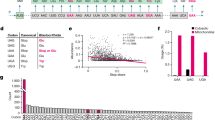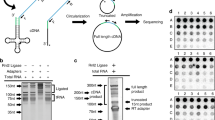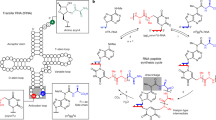Abstract
Transfer RNAs are ancient molecules present in all domains of life. In addition to translating the genetic code into protein and defining the second genetic code together with aminoacyl-tRNA synthetases, tRNAs act in many other cellular functions. Robust phenomenological observations on the role of tRNAs in translation, together with massive sequence and crystallographic data, have led to a deeper physicochemical understanding of tRNA architecture, dynamics and identity. In vitro studies complemented by cell biology data already indicate how tRNA behaves in cellular environments, in particular in higher Eukarya. From an opposite approach, reverse evolution considerations suggest how tRNAs emerged as simplified structures from the RNA world. This perspective discusses what basic questions remain unanswered, how these answers can be obtained and how a more rational understanding of the function and dysfunction of tRNA can have applications in medicine and biotechnology.
This is a preview of subscription content, access via your institution
Access options
Subscribe to this journal
Receive 12 print issues and online access
$189.00 per year
only $15.75 per issue
Buy this article
- Purchase on Springer Link
- Instant access to full article PDF
Prices may be subject to local taxes which are calculated during checkout


Similar content being viewed by others
References
Varshney, U. History of tRNA research. J. Biosci. 31, 437–496 (2006).
Giegé, R. & Frugier, M. Transfer RNA structure and identity. in Translation Mechanisms (eds. Lapointe, J. & Brakier-Gringas, L.) 1–24 (Landes Sciences, Georgetown, TX, 2003).
Ibba, M., Francklyn, C. & Cusack, S. The Aminoacyl-tRNA Synthetases 1–420 (Landes Bioscience, Georgetown, TX, 2005).
Stewart, T.S., Roberts, R.J. & Strominger, J.L. Novel species of tRNA. Nature 230, 36–38 (1971).
Dahlberg, J.E. tRNAs as primers for reverse transcriptase. in Transfer RNA: Biological Aspects (eds. Söll, D., Abelson, J.N. & Schimmel, P.R.) 507–514 (Cold Spring Harbor Laboratory Press, Cold Spring Harbor, NY, 1980).
Jahn, D., Verkamp, E. & Söll, D. Glutamyl-transfer RNA—a precursor of heme and chlorophyll biosynthesis. Trends Biochem. Sci. 17, 215–218 (1992).
Fechter, P., Rudinger-Thirion, J., Florentz, C. & Giegé, R. Novel features in the tRNA-like world of plant viral RNAs. Cell. Mol. Life Sci. 58, 1547–1561 (2001).
Sheppard, K. et al. From one amino acid to another: tRNA-dependent amino acid biosynthesis. Nucleic Acids Res. 36, 1813–1825 (2008).
Lee, T. & Feig, A.L. The RNA binding protein Hfq interacts specifically with tRNAs. RNA 14, 514–523 (2008).
Hopper, A.K. & Phizicky, E.M. tRNA transfers to the limelight. Genes Dev. 17, 162–180 (2003).
Dunin-Horkawicz, S. et al. MODOMICS: a database of RNA modification pathways. Nucleic Acids Res. 34, D145–D149 (2006).
Agris, P.F., Vendeix, F.A. & Graham, W.D. tRNA's wobble decoding of the genome: 40 years of modification. J. Mol. Biol. 366, 1–13 (2007).
Wolstenholme, D.R., Macfarlane, J.L., Okimoto, R., Clary, D.O. & Wahleithner, J.A. Bizarre tRNAs inferred from DNA sequences of mitochondrial genomes of nematode worms. Proc. Natl. Acad. Sci. USA 84, 1324–1328 (1987).
Helm, M. et al. Search for characteristic structural features of mammalian mitochondrial tRNAs. RNA 6, 1356–1379 (2000).
Ishitani, R. et al. Alternative tertiary structure of tRNA for recognition by a posttranscriptional modification enzyme. Cell 113, 383–394 (2003).
Tukalo, M., Yaremchuk, A., Fukunaga, R., Yokoyama, S. & Cusack, S. The crystal structure of leucyl-tRNA synthetase complexed with tRNALeu in the post-transfer-editing conformation. Nat. Struct. Mol. Biol. 12, 923–930 (2005).
McClain, W.H. Rules that govern tRNA identity in protein synthesis. J. Mol. Biol. 234, 257–280 (1993).
Giegé, R., Sissler, M. & Florentz, C. Universal rules and idiosyncratic features in tRNA identity. Nucleic Acids Res. 26, 5017–5035 (1998).
de Duve, C. The second genetic code. Nature 333, 117–118 (1988).
Ryckelynck, M., Giegé, R. & Frugier, M. Yeast tRNAAsp charging accuracy is threatened by the N-terminal extension of aspartyl-tRNA synthetase. J. Biol. Chem. 278, 9683–9690 (2003).
Fechter, P., Rudinger-Thirion, J., Théobald-Dietrich, A. & Giegé, R. Identity of tRNA for yeast tyrosyl-tRNA synthetase: tyrosylation is more sensitive to identity nucleotides than to structural features. Biochemistry 39, 1725–1733 (2000).
Pütz, J., Puglisi, J.D., Florentz, C. & Giegé, R. Identity elements for specific aminoacylation of yeast tRNAAsp by cognate aspartyl-tRNA synthetase. Science 252, 1696–1699 (1991).
Bonnefond, L., Giegé, R. & Rudinger-Thirion, J. Evolution of the tRNATyr/TyrRS aminoacylation systems. Biochimie 87, 873–883 (2005).
Hou, Y.-M. & Schimmel, P. A simple structural feature is a major determinant of the identity of a transfer RNA. Nature 333, 140–145 (1988).
McClain, W.H. & Foss, K. Changing the identity of a tRNA by introducing a G-U wobble pair near the 3′ acceptor end. Science 240, 793–796 (1988).
Musier-Forsyth, K. et al. Specificity for aminoacylation of an RNA helix: an unpaired, exocyclic amino group in the minor groove. Science 253, 784–786 (1991).
Musier-Forsyth, K. & Schimmel, P. Atomic determinants for aminoacylation of RNA minihelices and relationship to genetic code. Acc. Chem. Res. 32, 368–375 (1999).
Chang, K.Y., Varani, G., Bhattacharya, S., Choi, H. & McClain, W.H. Correlation of deformability at a tRNA recognition site and aminoacylation specificity. Proc. Natl. Acad. Sci. USA 96, 11764–11769 (1999).
Kikovska, E., Brannvall, M. & Kirsebom, L.A. The exocyclic amine at the RNase P cleavage site contributes to substrate binding and catalysis. J. Mol. Biol. 359, 572–584 (2006).
Seeman, N.C., Rosenberg, J.M. & Rich, A. Sequence-specific recognition of double helical nucleic acids by proteins. Proc. Natl. Acad. Sci. USA 73, 804–808 (1976).
Freyhult, E., Moulton, V. & Ardell, D.H. Visualizing bacterial tRNA identity determinants and antideterminants using function logos and inverse function logos. Nucleic Acids Res. 34, 905–916 (2006).
Jako, E. et al. In silico detection of tRNA sequence features characteristic to aminoacyl-tRNA synthetase class membership. Nucleic Acids Res. 35, 5593–5609 (2007).
Lehn, J.-M. Supramolecular chemistry: from molecular information towards self-organization and complex matter. Rep. Prog. Phys. 67, 249–265 (2004).
Tomita, K., Ishitani, R., Fukai, S. & Nureki, O. Complete crystallographic analysis of the dynamics of CCA sequence addition. Nature 443, 956–960 (2006).
Hirsh, D. Tryptophan transfer RNA as the UGA suppressor. J. Mol. Biol. 58, 439–458 (1971).
Cochella, L. & Green, R. An active role for tRNA in decoding beyond codon: anticodon pairing. Science 308, 1178–1180 (2005).
Pütz, J., Puglisi, J.D., Florentz, C. & Giegé, R. Additive, cooperative and anti-cooperative effects between identity nucleotides of a tRNA. EMBO J. 12, 2949–2957 (1993).
Frugier, M., Florentz, C. & Giegé, R. Efficient aminoacylation of resected RNA helices by class II aspartyl-tRNA synthetase dependent on a single nucleotide. EMBO J. 13, 2218–2226 (1994).
Eriani, G. & Gangloff, J. Yeast aspartyl-tRNA synthetase residues interacting with tRNAAsp identity bases connectively contribute to tRNAAsp binding in the ground and transition state complex and discriminate against non-cognate tRNAs. J. Mol. Biol. 291, 761–773 (1999).
Sampson, J.R., DiRenzo, A.B., Behlen, L.S. & Uhlenbeck, O.C. Nucleotides in yeast tRNAPhe required for the specific recognition by its cognate synthetase. Science 243, 1363–1366 (1989).
Frugier, M., Helm, M., Felden, B., Giegé, R. & Florentz, C. Sequences outside recognition sets are not neutral for tRNA aminoacylation: evidence for non-permissive combinations of nucleotides in the acceptor stem of yeast tRNAPhe. J. Biol. Chem. 273, 11605–11610 (1998).
Hou, Y.M. & Schimmel, P. Functional compensation of a recognition-defective transfer RNA by a distal base pair substitution. Biochemistry 31, 10310–10314 (1992).
Li, W. & Frank, J. Transfer RNA in the hybrid P/E state: correlating molecular dynamics simulations with cryo-EM data. Proc. Natl. Acad. Sci. USA 104, 16540–16545 (2007).
Budiman, M.E., Knaggs, M.H., Fetrow, J.S. & Alexander, R.W. Using molecular dynamics to map interaction networks in an aminoacyl-tRNA synthetase. Proteins 68, 670–689 (2007).
Eargle, J., Black, A.A., Sethi, A., Trabuco, L.G. & Luthey-Schulten, Z. Dynamics of recognition between tRNA and elongation factor Tu. J. Mol. Biol. 377, 1382–1405 (2008).
Jacobson, K.B. Reaction of aminoacyl-tRNA synthetases with heterologous tRNA's. Prog. Nucleic Acid Res. Mol. Biol. 11, 461–488 (1971).
Stehlin, C. et al. Species-specific differences in the operational code for aminoacylation of tRNAPro. Biochemistry 37, 8605–8613 (1998).
Helm, M., Giegé, R. & Florentz, C.A. Watson-Crick base-pair disrupting methyl group (m1A9) is sufficient for cloverleaf folding of human mitochondrial tRNALys. Biochemistry 38, 13338–13346 (1999).
Nameki, N. et al. E. coli tRNAAsp recognition mechanism differing from that of the yeast system. Biochem. Biophys. Res. Commun. 189, 856–862 (1992).
Moulinier, L. et al. The structure of an AspRS-tRNAAsp complex reveals a tRNA-dependant control mechanism. EMBO J. 20, 5290–5301 (2001).
Bonnefond, L. et al. Crystal structure of human mitochondrial tyrosyl-tRNA synthetase reveals common and idiosyncratic features. Structure 15, 1505–1516 (2007).
Tworowski, D., Feldman, A.V. & Safro, M.G. Electrostatic potential of aminoacyl-tRNA synthetase navigates tRNA on its pathway to the binding site. J. Mol. Biol. 350, 866–882 (2005).
Tryoen-Tóth, P. et al. Proteomic consequences of a human mitochondrial tRNA mutation beyond the frame of mitochondrial translation. J. Biol. Chem. 278, 24314–24323 (2003).
Gindulyte, A. et al. The transition state for formation of the peptide bond in the ribosome. Proc. Natl. Acad. Sci. USA 103, 13327–13332 (2006).
Harms, J. et al. High resolution structure of the large ribosomal subunit from a mesophilic eubacterium. Cell 107, 679–688 (2001).
Korostelev, A., Trakhanov, S., Laurberg, M. & Noller, H.F. Crystal structure of a 70S ribosome-tRNA complex reveals functional interactions and rearrangements. Cell 126, 1065–1077 (2006).
Selmer, M. et al. Structure of the 70S ribosome complexed with mRNA and tRNA. Science 313, 1935–1942 (2006).
Frank, J., Gao, H.X., Sengupta, J., Gao, N. & Taylor, D.J. The process of mRNA-tRNA translocation. Proc. Natl. Acad. Sci. USA 104, 19671–19678 (2007).
Fei, J., Kosuri, P., MacDougall, D.D. & Gonzalez, R.L., Jr . Coupling of ribosomal L1 stalk and tRNA dynamics during translation elongation. Mol. Cell 30, 348–359 (2008).
Stapulionis, R. & Deutscher, M.P. A channeled tRNA cycle during mammalian protein synthesis. Proc. Natl. Acad. Sci. USA 92, 7158–7161 (1995).
Moore, S.D. & Sauer, R.T. The tmRNA system for translational surveillance and ribosome rescue. Annu. Rev. Biochem. 76, 101–124 (2007).
Bessho, Y. et al. Structural basis for functional mimicry of long-variable-arm tRNA by transfer-messenger RNA. Proc. Natl. Acad. Sci. USA 104, 8293–8298 (2007).
Bailly, M., Blaise, M., Lorber, B., Becker, H.D. & Kern, D. The transamidosome: a dynamic ribonucleoprotein particle dedicated to prokaryotic tRNA-dependent asparagine biosynthesis. Mol. Cell 28, 228–239 (2007).
Romby, P. & Springer, M. Bacterial translational control at atomic resolution. Trends Genet. 19, 155–161 (2003).
Ryckelynck, M., Masquida, B., Giegé, R. & Frugier, M. An intricate RNA structure with two tRNA-derived motives directs complex formation between yeast aspartyl-tRNA synthetase and its mRNA. J. Mol. Biol. 354, 614–629 (2005).
Schimmel, P., Giegé, R., Moras, D. & Yokoyama, S. An operational RNA code for amino acids and possible relationship to genetic code. Proc. Natl. Acad. Sci. USA 90, 8763–8768 (1993).
Sun, F.J. & Caetano-Anolles, G. The origin and evolution of tRNA inferred from phylogenetic analysis of structure. J. Mol. Evol. 66, 21–35 (2007).
Rodin, S., Rodin, A. & Ohno, S. The presence of codon-anticodon pairs in the acceptor stem of tRNAs. Proc. Natl. Acad. Sci. USA 93, 4537–4542 (1996).
Blaise, M. et al. A minimalist glutamyl-tRNA synthetase dedicated to aminoacylation of the tRNAAsp QUC anticodon. Nucleic Acids Res. 32, 2768–2775 (2004).
Salazar, J.C., Ambrogelly, A., Crain, P.F., McCloskey, J.A. & Söll, D. A truncated aminoacyl-tRNA synthetase modifies RNA. Proc. Natl. Acad. Sci. USA 101, 7536–7541 (2004).
Maizels, N. & Weiner, A.M. Phylogeny from function: evidence from the molecular fossil record that tRNA originated in replication, not translation. Proc. Natl. Acad. Sci. USA 91, 6729–6734 (1994).
Yakhnin, A.V. A model for the origin of protein synthesis as coreplicational scanning of nascent RNA. Orig. Life Evol. Biosph. 37, 523–536 (2007).
Guo, J., Wang, J., Anderson, J.C. & Schultz, P.G. Addition of an a-hydroxy acid to the genetic code of bacteria. Angew. Chem. Int. Ed. 47, 722–725 (2008).
Florentz, C., Sohm, B., Tryoen-Tóth, P., Pütz, J. & Sissler, M. Human mitochondrial tRNAs in health and disease. Cell. Mol. Life Sci. 60, 1356–1375 (2003).
Kuchino, Y., Borek, E., Grunberger, D., Mushinski, J.F. & Nishimura, S. Changes of post-transcriptional modification of wye base in tumor-specific tRNAPhe. Nucleic Acids Res. 10, 6421–6432 (1982).
Randerath, K., Agrawal, H.P. & Randerath, E. tRNA alterations in cancer. Recent Results Cancer Res. 84, 103–120 (1983).
Brandon, M., Baldi, P. & Wallace, D.C. Mitochondrial mutations in cancer. Oncogene 25, 4647–4662 (2006).
Salinas, T. et al. The voltage-dependent anion channel, a major component of the tRNA import machinery in plant mitochondria. Proc. Natl. Acad. Sci. USA 103, 18362–18367 (2006).
Acknowledgements
This perspective is based on an invited talk given at the 22nd tRNA Workshop in Uppsala (November 1–6, 2007). It has benefited from the input of my Strasbourg colleagues and students and the exchange over years of ideas and knowledge with many contributors from the tRNA community. Because of space limitations, all contributors could not be explicitly mentioned and I apologize for this. Particular thanks are due to C. Florentz, W. Hosseini and L. Kirsebom for comments on the manuscript. A. Gaudry and C. Sauter are acknowledged for help in figure preparation. This work was supported by the Centre National de la Recherche Scientifique, Université Louis Pasteur, and ACI BCMS “Code génétique: mieux connaître ses déviations pour comprendre son évolution.”
Author information
Authors and Affiliations
Rights and permissions
About this article
Cite this article
Giegé, R. Toward a more complete view of tRNA biology. Nat Struct Mol Biol 15, 1007–1014 (2008). https://doi.org/10.1038/nsmb.1498
Received:
Accepted:
Published:
Issue Date:
DOI: https://doi.org/10.1038/nsmb.1498
This article is cited by
-
tRNA therapeutics for genetic diseases
Nature Reviews Drug Discovery (2024)
-
Investigation of tRNA-based relatedness within the Planctomycetes−Verrucomicrobia−Chlamydiae (PVC) superphylum: a comparative analysis
Archives of Microbiology (2023)
-
Transfer RNA-derived small RNA: an emerging small non-coding RNA with key roles in cancer
Experimental Hematology & Oncology (2022)
-
The tRNA regulome in neurodevelopmental and neuropsychiatric disease
Molecular Psychiatry (2022)
-
PtRNAdb: a web resource of plant tRNA genes from a wide range of plant species
3 Biotech (2022)



